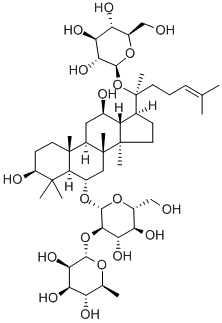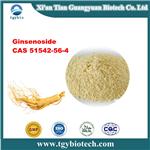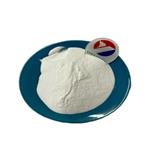Definition
ChEBI: Ginsenoside Re is a ginsenoside found in Panax ginseng that is dammarane which is substituted by hydroxy groups at the 3beta, 6alpha, 12beta and 20 pro-S positions, in which the hydroxy groups at positions 6 and 20 have been converted to the corresponding alpha-L-rhamnopyranosyl-(1->2)-beta-D-glucopyranoside and beta-D-glucopyranoside respectively, and in which a double bond has been introduced at the 24-25 position. It has a role as a plant metabolite, an antioxidant, a neuroprotective agent, an anti-inflammatory agent, an antineoplastic agent and a nephroprotective agent. It is a 12beta-hydroxy steroid, a 3beta-hydroxy steroid, a beta-D-glucoside, a ginsenoside, a tetracyclic triterpenoid, a disaccharide derivative and a 3beta-hydroxy-4,4-dimethylsteroid. It derives from a hydride of a dammarane.
Biochem/physiol Actions
Ginsenoside Re is a phytosterol found in the ginseng root. Ginsenoside Re is believed to be the main contributor to ginseng′s protection against damage from cardiac ischemia by inhibiting calcium accumulation in the mitochondria. It has been shown that Ginsenoside Re inhibits calcium buildup through activation of endothelial nitric oxide synthase (eNOS) to release NO and activate delayed rectifier K+ currents.




